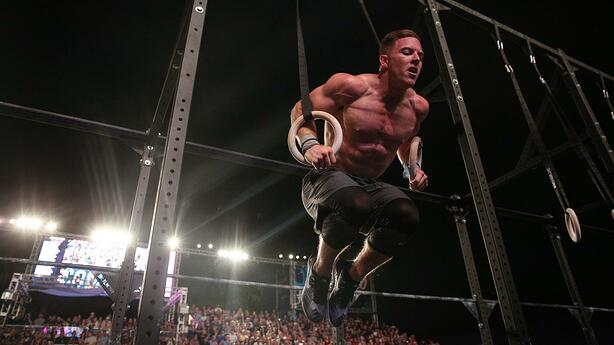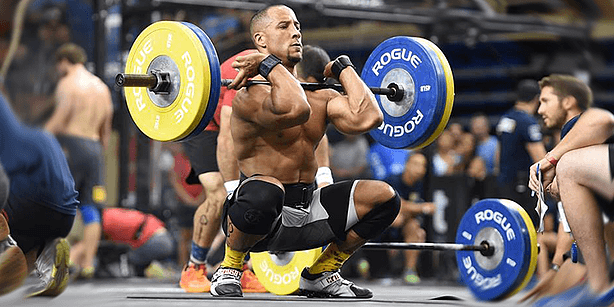6 Methods CrossFit Competitors Should Use to Develop Raw Strength
Strength & ConditioningABOUT THE AUTHOR

Todd Nief
Todd Nief is the Owner and Director of Training at South Loop Strength and Conditioning. He blogs regularly on all things strength and conditioning at southloopsc.com/articles
// Developing raw strength for crossfit
Now that Regionals is over, it’s the off-season for most athletes who compete in CrossFit as a sport.
And you know that means most of them are thinking – “it’s time to do a strength cycle!”
So competitive fitness athletes across the nation are hopping on the internet, checking out forums, and scrolling through Instagram posts.
Some will try Wendler’s 5/3/1
Some will put together a version of a Westside conjugate cycle
Some will read an article on Bulgarian weightlifting and start maxing out their squat every day
And there’s probably a special individual out there who is going to layer the Smolov cycle on top of a lifting cycle from Catalyst athletics and do the CompTrain conditioning workouts as PM sessions. Good luck to them.
There are sound principles behind the designs of all these programs (except maybe that last Smolov/Catalyst/CompTrain hybrid…) in terms of building absolute strength.
But athletes can often get in trouble when they attempt to use strength programs designed specifically for powerlifting or for hypertrophy with CrossFit programs. They often don’t understand the principles behind the programs, nor do they fully understand what makes athletes successful in the Open and Regionals.

For many athletes, they’re making the right call by focusing on strength in the “off-season.”
The third barbell in Open Workout 17.3 this year was at 225/155 – which just three or four years ago was a solid max snatch for an athlete at Regionals. Muscle-ups and handstand push-ups have become staples of the Open.
If you don’t have the buy-in strength to compete at the level you wish to compete at – whether that’s qualifying for Regionals, getting into the top 200 in your region in the Open, or just improving from last year – now is a good time to work on it.
// Your Tools For Absolute Strength
This is the stuff that Instagram posts are made of. This is also one of the most important baseline areas to develop in order to be able to perform competitively in CrossFit.
If you can’t lift the weight as prescribed or if you can’t do a muscle-up, you get to spend a lot of time in competition staring at a barbell or a set of rings.
There are all kinds of programs designed around developing absolute strength. Most of them are effective – at least for some people, some of the time.

There are principles of some of these programs that are applicable to CrossFit athletes, but that doesn’t mean simply layering a powerlifting template or a weightlifting template on top of some metcons culled from blogs is going to be an effective training program.
My goal here is to extract some principles from these programs in terms of how specific sessions may be designed and give some context for including them in the program of a competitive fitness athlete.
It’s The Off-Season. Time To Get Strong. Check out the 12-week template here.
- 1. Volume-Based Session
- 2. Intensity-Based Session
- 3. Accessory Work
- 4. Tempo Protocols
- 5. Specific Positional Work
- 6. Variations In Main Exercise
There is a continuous debate in the strength and conditioning world about “volume” vs. “intensity.” The reality is – just like in most complex and emergent things – the answer’s “it depends and no one really knows.”
Let’s just say that a CrossFit athlete must train both volume and intensity throughout the year, but some people seem to respond better to one style of session over the other.
How can you tell which is for you?
- Do you feel like it takes you a lot of warm-up sets to get to a heavy triple? Do you tend to hit PRs at the end of EMOMs? You’re probably a volume responder.
- Do you prefer to take big, quick jumps to build to a heavy triple? Do you find yourself feeling crushed for a few days after pushing the intensity on a workout with a lot of volume? You’re probably an intensity responder.
The rules here are made to be broken, but let’s say that a “volume-based session” includes more than 20 repetitions at a working weight over somewhere around 80% of one rep max.

In this example, were dealing with 30 total working reps split into sets of 6.
Front Squat
5×2.2.2; Across; Rest 2 min
*Re-rack between sets of 2
For progression, we can increase the weight across weeks. We can do that by either linearly building in weight weekly while maintaining the same reps and sets, or by decreasing reps, decreasing sets, or increasing rest time to enable heavier weights to be lifted.
If our rule of thumb for a volume-based session was over 20 working reps at greater than 80% of 1RM, our intensity-based sessions usually have far fewer reps than that.
Let’s use a version of a front squat session to illustrate this type of training as well:
Front Squat
Build quickly to a tough triple for today in 10 min
*Start moderate and take big jumps
For a prototypical “intensity responder,” they may be able to build to a tough triple in 5 sets with big jumps. Let’s use an avatar of a male athlete shooting for 365 on his tough triple.
His jumps may look something like this:
45 x5/135 x5/225 x5/275 x3/325 x3/365 x3
To a more volume-biased athlete, that probably looks insane, but this feels totally reasonable to a certain type of athlete.
How do we progress this type of session? On a weekly basis, we can decrease the number of reps – thus increasing the weight lifted. We could start at 5, then go 4, 3, 2, 1 over the next several weeks.
Adding in variations of the main training lifts for slightly higher repetitions has a long track record of success in any strength sport.
One of the best ways to do this is to superset opposing movements (horizontal upper body pushing/horizontal upper body pulling, squatting/hinging, etc.) for sets of 6-15 reps with moderate rest in between sets.
In this example, we have a single-leg squatting-based movement paired with a bilateral hinging-based movement.
A1. Rear-Foot Elevated Split Squats
3×8/leg; 30×1 tempo; Building; Short rest b/w legs; Rest 60s
A2. Clean-Grip RDLs
3×8; 30×1 tempo; Building; Rest 60s
We can progress this just like the other sessions by adding volume, adding weight, or decreasing rest.
In advanced athletes, there’s also value in rotating exercises somewhat regularly. In this case, we may decided to make the following week something like this:
A1. Front Rack Step-Ups to 24″
3×8/leg; 30×1 tempo; Building; Short rest b/w legs; Rest 60s
A2. Safety Bar Good Mornings
3×8; 30×1 tempo; Building; Rest 60s
Bodybuilders and powerlifters have been using prescribed tempos for ages in order to increase the time under tension of a lift and train problem areas in the range of motion or in muscle development.
While CrossFit traditionally calls for maximizing power output and intensity during a training session, there is sometimes magic in improving both the eccentric and isometric portions of a lift…
…which can be done through prescribing specific tempos.
Tempo training can get all kinds of complicated, but for a relatively simple example, here are some back squats with a 4 count eccentric (lowering), no pause in the bottom, explosive concentric (raising), and a 1 count pause up top.
If you’re honest on these 4 count tempos, this type of training can be very humbling – particularly for the highly explosive athletes who rely extensively on stretch reflex to get through movements.

Back Squat
5×3; 4×1 tempo; Across; Rest 2-3 min
Progressing a tempo-based session can follow the exact same rules of thumb discussed for the volume- and intensity-based sessions above. Or, you can manipulate the tempo itself, typically moving from slower eccentrics and longer pauses into more explosive work.
In addition to tempo training, we can also force pauses at various stages of a lift. This is great for developing body awareness by taking away the ability to speed through transitions or difficult areas. It also forces you to create a large amount of isometric tension.
I have found pausing in certain ranges of motion to be one of the better tools for improving hinging in CrossFit athletes – particularly those who struggle with back issues when doing a lot of deadlifting volume.
The pauses are self-limiting in terms of the amount of weight that they can use. It also creates more awareness surrounding positions and how stability is being created through the range of motion.
In this example session, we’re focusing on the deadlift:

Deadlift w/ 1s pause at mid-shin
4×4; Across; Rest 2 min
*Reset each rep
Progression here can follow the same rules in terms of changing volume, intensity, and rest. But we can also adjust either the time paused or the position of the pause.
In the above example, we may progress this by moving the pause further up the range of motion:
Deadlift w/ 1s pause above-the-knee
4×4; Across; Rest 2 min
*Reset each rep
Westside Barbell has become famous for constantly varying the exercise they use on their max effort days. By switching bars and ranges of motion, they avoid overtraining specific movement patterns and force learning and adaptation to slightly different patterns.
Now, this variation can go too far and can prevent developing proper skill in certain movements (which is why you don’t see weightlifters changing the type of bar that they snatch on every week).
But – just like almost everything discussed in this article – there is a pendulum that can swing too far in both directions.
Some variations reduce the total amount of load possible to be lifted in a specific pattern. If we take the deadlift, we can change the grip to significantly decrease the amount of load an athlete is pulling:
Double Overhand Deadlift, no hook grip – 2” riser
Build to a tough 5 for today in 10 min
*Reset each rep
**Should be less than a tough set of 5 for a conventional deadlift
Similarly, we can also dramatically increase the load an athlete can lift in a deadlift by shortening the range of motion:
Rack pulls from above-the-knee
Build to a tough 5 for today in 10 min
*Reset each rep
**Should be more than a tough set of 5 for a conventional deadlift
These variations of the main lifts can be used as accessory work, or can be rotated in as focus lifts for either a training session or a cycle.
It’s The Off-Season. Time To Get Strong. Check out the 12-week template here.
// Complete Off-Season Training for Competitive CrossFit: Coming Soon…
- Part 2: Get Powerful
- Part 3: Get Fit
- Part 4: Dominate
Are you a better coach after reading this?
More coaches and athletes than ever are reading the TrainHeroic blog, and it’s our mission to support them with usefull training & coaching content. If you found this article useful, please take a moment to share it on social media, engage with the author, and link to this article on your own blog or any forums you post on.
Be Your Best,
TrainHeroic Content Team
HEROIC SOCIAL
HEROIC SOCIAL
TRAINING LAB
Access the latest articles, reviews, and case studies from the top strength and conditioning minds in the TH Training Lab

